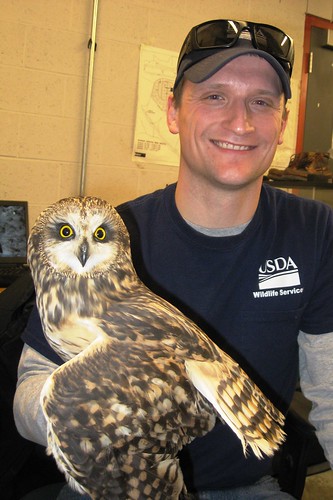
Seeing a short-eared owl in November on the Pittsburgh International Airport, where I work as an airport wildlife biologist, was a unique occasion. However, as the number of owls grew to eight, I recognized the challenge ahead: Like all birds of prey, short-eared owls are a recognized potential aviation hazard. Their low rolling flight and difficult-to-disperse reputation means they pose an aviation safety threat. From 1990-2012, short-eared owl strikes with aircraft in the United States caused over $1 million in damage, and often are fatal to the birds. Convincing them to leave would be difficult but important.
The task would be harder because short-eared owls are listed by the State as an endangered species. Common in many areas globally, Pennsylvania is the southernmost edge of their breeding range. These owls likely migrated from Canadian breeding grounds to winter in Pennsylvania.
Calls to wildlife staff of the Pennsylvania Game Commission confirmed trap-and-relocate was an option to address the sudden population increase at the airport. Game Commission staff identified and secured property-owner agreement to use a 500-acre reclaimed strip mine site to release any owls I would capture. The Commission also connected me with ornithologist and bander Bob Mulvihill of the National Aviary of Pittsburgh.
On December 30, I live-captured an owl on the airfield using a pole trap. Mulvihill examined the owl, recording its weight, sex and approximate age (an immature female about 14 ounces). After banding, she was successfully released at the identified site in Washington County, about 20 miles away.
Mine was the twelfth short-eared owl relocated away from an airport by USDA Wildlife Services (WS) staff in five states (OH, IN, IL, MI and PA) in 2013. Later, I would successfully trap and release 3 more owls bringing the regional WS total to 17 capture/relocations this winter.
As I began the trapping project, I also consulted with Dr. Brian Washburn, an avian research biologist with WS’ National Wildlife Research Center. He is working to deploy radio transmitters that will be fitted onto the owls to provide real-time tracking data, which will increase knowledge about the owls, their movement patterns, and how that impacts aviation safety. Our partnership highlights the way WS’ research and operations work together to increase aviation safety, learn more about State-listed T&E species, and cooperate with our State partners.
Our work is paying dividends for both aviation and short-eared owls, which are also State-endangered in Michigan, Indiana, and Illinois and of special concern in Minnesota and Ohio. Since 2006, in the continental U.S., WS has chased nearly 2,000 short-eared owls away from conflict situations and from 2006-2012, we captured and relocated 31 short-eared owls. As our efforts help us learn more about these birds and their behavior, we hope to assist their local recovery while improving aviation safety.



